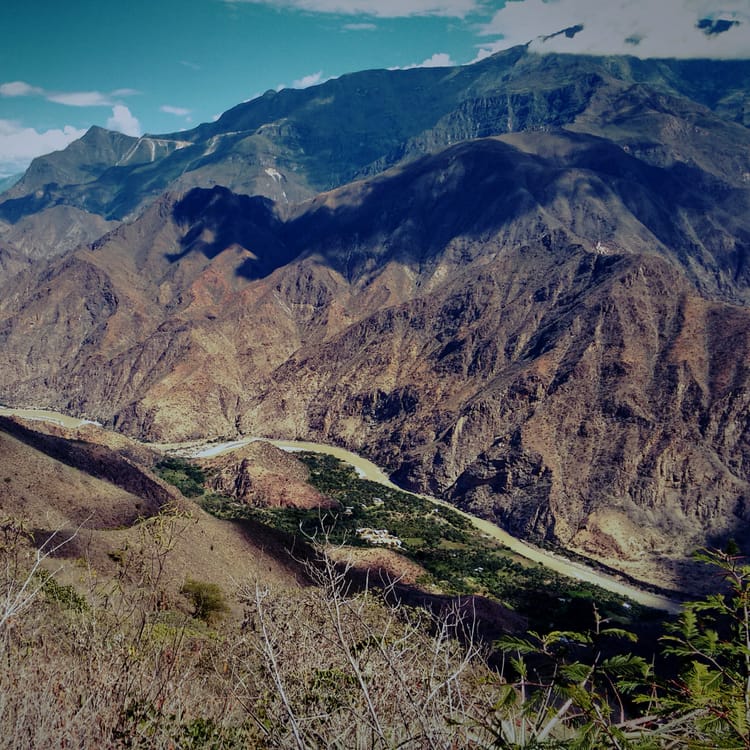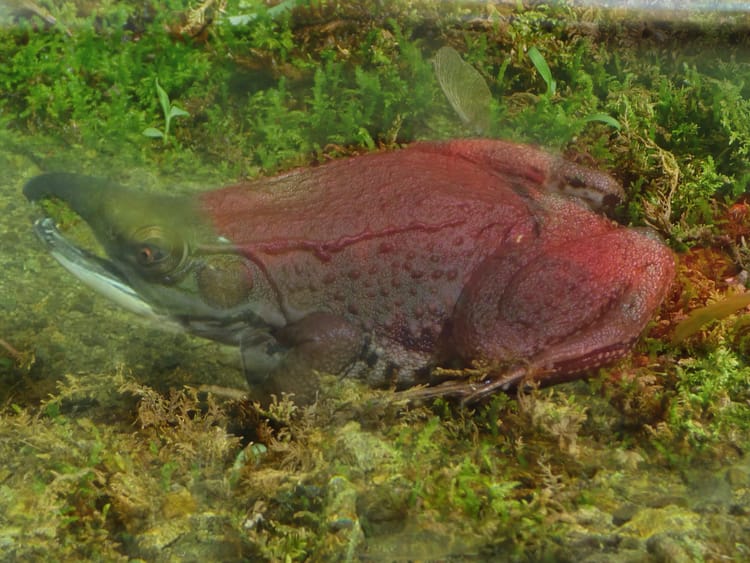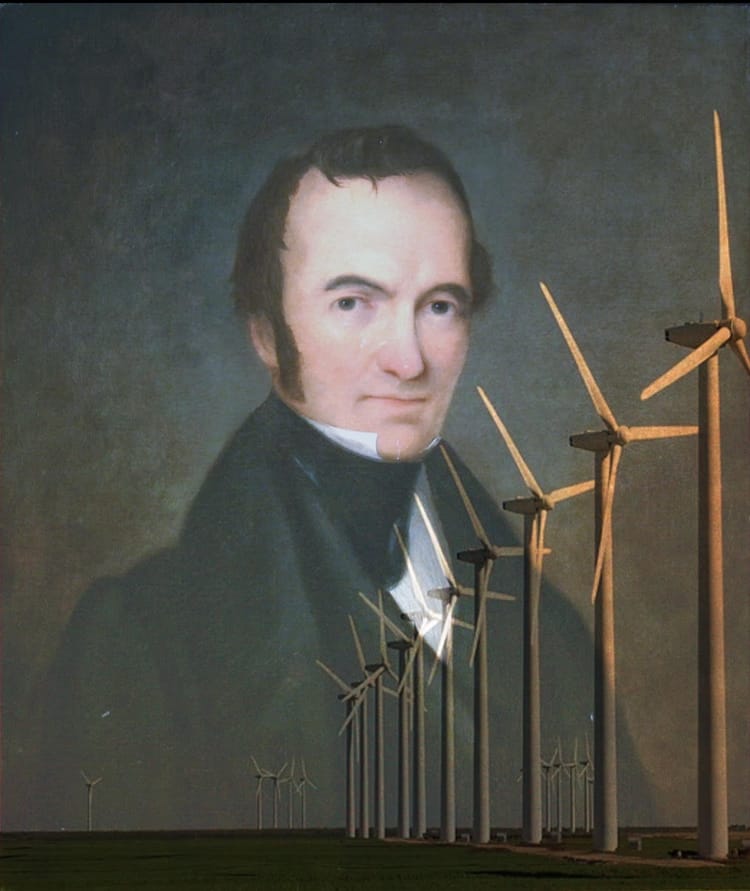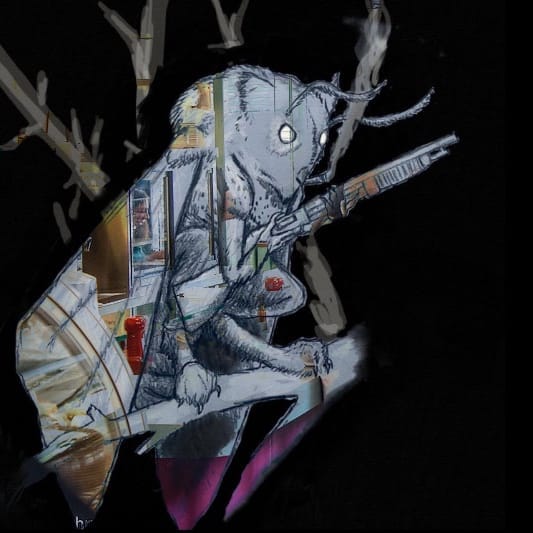Cherry-Scented Ghosts

There is little more uncanny than the American lawn. Originally formed by the relentless grazing of hoofed animals in and around France and England's many villages, they eventually became a status symbol of the aristocracy: enclosed estates of green, rolling fields of cleared land, put to no great economic purpose. In the 1700s, when Lois XIV's chief gardener pioneered a form that was wholly deocrative: the tapis vert, or "green carpet."
As Virginia Jenkins writes in The Lawn: A History of an American Obsession, those carpets jumped back to England, for parks and manor houses, and to America, where settlers sought to emulate European lawns in an ecosystem that did was not especially friendly to them. Grass itself was somewhat rare in the heavily wooded eastern parts of the continent; it would have to be manufactured. In 1780, the Shakers – a community of Protestant ecstatics – began growing it for livestock, a practice that soon spread to other colonial cities eager to terraform this new country, to transform its unruly-looking, native-managed agroforestry into something more comfortably English.
The thing about grass is that it likes very much to grow, and grow tall; the thing about lawns is that the green carpet is supposed to be short. Lawns thus require a tremendous amount of upkeep, the sort that kept them as a fancy of the wealthy. Only with the 1830 invention and 1860s popularization of the lawnmower did the middle classes begin to get green carpets of their own – and they loved them. Eventually, enough people had them that the lawn was no longer a status symbol but a beloved aesthetic: a tamed, sterile nature that marched out alongside the suburbs, the grasses mowed and mowed again, fertilized to within an inch of their lives, any inconvenient native plants that tried to sprout chemically carpet-bombed into submission. By the 1950s – as flags of sod were grown and shipped and laid down wholesale – the tapis vert were not metaphorical carpets but something very close to real ones. Everywhere you looked, there they were: carpets of grass, smothering all that lay below: living, and yet not alive, the way a meadow is alive,. The hand of a now-forgotten past, choking the future.
You might – if you were feeling cheeky – go so far as to call them undead.
Welcome to Heat Death, the newsletter that knows where – and why – the grass is greener. It's been a busy few weeks here for the Brothers Elbein, both of whom are going through moments of transition. Saul, as we've mentioned, welcomed his newest son. On Friday, Asher will be getting married. The past weeks, therefore, have necessitated a fair amount of rushing around.
Today, therefore, we're thrilled at the oppurtunity to run a guest piece by horror author and editor extraodinaire Wendy N. Wagner. Wendy's novels include Girl in the Creek and The Deer Kings, her short fiction has been nominated for the Theodore Sturgeon and Shirley Jackson awards, and she also earned a Locus award for her editing of Nightmare Magazine. She is, in other words, well aquainted with ghosts. But as a trail runner, hiker and gardener, she's increasingly come to wonder whether some hauntings are more subtle and strange than the haints and revenants of fiction. And while she writes about her home in Oregon, the restless past she describes is woven deeply into the landscape around us: in the streams, in the trees, and very often, in the grass itself.
This is Heat Death. Stay with us.
Wendy here. If you want to dig a hole in my backyard, you need a sharp shovel and a lot of muscle. It’s not the grass that resists the blade – although, decades old and left unthatched for years, the sod is nearly as tough as an old tire – but rather the green plastic threads below its roots.
At the time our lawn was planted, the industry practice was to sow grass seed over an expanse of soil and plastic netting. When it was ready to “install” – like vinyl flooring, new baseboards, or anything else you’d buy at Home Depot – the whole mess of plants, dirt, and plastic was cut into strips, rolled tight, and then driven to the site, which had been sprayed and rototilled and flattened until the new lawn could be unfurled like a fresh carpet. And like the polyester shag carpets made popular at the same time as this turf technology, the plastic just lay there, unchanged by sun, water, squirrels, and the passing of years. In a few places, moles managed to break through the tough netting to raise up their mounds. But by and large it stayed hidden, laying deep beneath the surface of the greenery, silently binding the earth.
It'd be easy to forget it's even there. Except – we’ve dug up handful after handful of the stuff as we’ve planted trees and vegetable beds. Little clumps appear in unexpected places: a palm-sized swathe a crow left in the birdbath, a potato I once harvested with green threads passing through its middle. Every time those green plastic bits appear, it is a reminder of the history of our house, that it had once been owned by someone who liked a smooth, fresh lawn, and had bought one in an era before we began to question the safety of plastic.
Every home contains little reminders of its history: the lead paint hidden beneath layers of latex, the pipes of questionable material, the lack of working electrical outlets. Some of these oddities contain whispers of the personalities of previous owners, like the holes left on our walls from paintings hung and removed before we ever set foot in this house. Some of them are legacies of policies and systems that drove residential construction in eras past. Electrical codes, for example, have changed significantly since our house was built. People didn’t use as much electricity in 1959, so the line joining our house to the main electrical grid simply couldn’t carry as many watts as our 21st century washer and dryer demanded. But societal norms have changed, too. Our kitchen is only big enough for one cook because in the fifties, only the woman of the house was expected to be doing any cooking.
Most of that history is tucked away, unnoticeable except when old decisions – like the plastic roots in the grass – create problems we’re forced to deal with. But other parts of it continue to quietly influence the way we use our home. The decades-old choice to put the cable line in the smallest bedroom means that room has become my office. The arrangement of three-pronged outlets in the kitchen has determined the placement of all our appliances; the fact that one of the only outlets in the living room is controlled by an on/off switch told us where to put our electronics, and thus, the couch. Where I spend the minutes and hours of my day was mostly decided for me by a group of strangers working together seventy years ago.
In this sense, my house is haunted. For me, a horror writer, it’s a quieter, more subtle form of haunting than the shrieking fiends you tend to find in fiction. I always wanted to move into a house that rattled and thumped in the night, waking me with the legacy of its former inhabitants. It took me years to realize that those inhabitants have been communicating with me all the time. They just did so in ways the horror genre didn’t prepare me to listen for.
The right kind of medium, or at least a historian or a naturalist, can interpret the voices of the dead as they whisper in our houses and our parks. They are constantly speaking, even in the footings of bridges or the verges of our freeways. The stories of the dead unfold from the land itself.
Every inch of our planet has been occupied by creatures — humans and otherwise — whose presence or absence has left their mark upon the landscape. Those marks have consequences: the historicity of our environment, like the history of my house, controls our behavior in ways we don’t always notice or want to notice. Old land-use decisions shape our roads, rail lines, and neighborhoods to this very day. They are quiet ghosts, haunting us with stories we’ve paved over.
The town where I live, for example, is haunted by cherries. The orchards that once made Milwaukie, Oregon, famous are long gone, but their ghosts remain in the shape of the town, the names of its streets, the stands at the farmer’s market.
No one living here today knows the location of the first Bing cherry tree. Some argue Seth Lewelling planted these cultivars of the wild cherry at his brother Henderson’s orchard, down alongside the Willamette River, just a quarter mile or so from the mouth of Johnson Creek — a property that today boasts Oregon state’s most exclusive country club. Others believe Seth and his assistant, the Chinese-American Ah Bing, worked on the Bing solely on Seth’s farm in Milwaukie proper, snug in the crook of Johnson Creek’s arm.
Sometimes when I walk through town, I wonder what Lewelling and Ah Bing would tell me if I could summon them from the land of the dead. Would they lead me behind the train tracks to show me a stump, a tracing of roots, a square foot of pavement breathing only the faintest sweetness of cherries? Would they look at the compacted earth beside the expressway that had once been a thriving orchard and mourn the care and effort they had poured into that land?
Other ghosts manifest on the Springwater Corridor — a multi-use path built on the bed of a former railroad line. Extending from a spot just north of Seth Lewelling’s former orchard out along the boundary between Portland and Milwaukie, the trainline connected people to farms, one of the region’s largest sawmills, and even two amusement parks. The creek brought the development of the modern community; its constant floods also threatened it.
It would be wrong to say that before white settlement Johnson Creek was a flood-prone waterway with associated wetlands. Before European settlers wiped out native beaver populations, almost all streams and creeks in North America were wider, wetter, choked and tamed by vegetation and decomposing plant materials. Like most such creeks, Johnson Creek must have had its channels of free-moving water, but by and large, the water flowing through East Portland’s valleys looked more like a slowly-moving swamp, or a wetland with a current, than the cover art from a Trout Unlimited calendar.
In fact, early settlers appreciated such innundations. Farmers added 180-degree bends to the creek to encourage its meandering, and to more widely spread its soil-laden floodwaters across their fields. But as farms were divided and replaced with rail lines, industry and houses, people demanded more control over the watershed. In the 1930s, the Works Progress Administration straightened and deepened the lower fifteen miles of Johnson Creek, lining its bottom and banks with rocks quarried from a natural amphitheater that is now an enormous industrial park.
Today, both the WPA channel and the industrial park are unsettling places to visit. Where the Springwater Corridor follows the edge of the industrial park, deer graze beneath industrial power lines. Local kids pick blackberries with their parents. Runners speed along, intently ignoring lots packed with stacks of crushed cars. And year after year, despite the addition of drainage systems and tons of infill (not all of it legal), the industrial park and the neighborhoods surrounding it are shaken by the spirits of the creek. The people who live here sleep badly on certain nights in late winter, afraid for themselves, or at least their houses. The ghosts out here don’t rattle chains: they gurgle and burble, sluice and splash. They speak in the creek’s own voice, using its loudest tone: the flood.
Changing the creek’s channel didn’t make the creek any less prone to flooding, either. Research in hydrology suggests that the best way to minimize flooding is to spread out the water in a watershed, to slow it and allow it to sink into natural underground aquifers. Wetlands and swamps do a far better job protecting lowland developments from flooding than hardening creek banks or building levees and dams. Adding pavement and stone to Milwaukie’s waterways simply guaranteed they would run wilder, growl louder, and grow larger.
You can feel the uncanniness of the stretches of the creek where the stone-lined WPA channel remains. Overhung by blackberry brambles, cottonwood trees, and elderberry bushes, the creek looks wild and free. Insects dapple the surface of the water, and if you look carefully, you can catch glimpses of small fish swimming near the bottom. But something feels distinctly off about the landscape, something that makes the viewer step closer and take a second look. Then you see the green moss-slicked banks are too steep for any normal creek, are marked with a faint pattern of squared blocks like the ruins of some medieval castle. The quietly gothic stonework is beautiful, but it’s clearly not natural. It’s lovely but wrong: too unkempt for the human world, and too rigid to be nature.
Sometimes I think I should separate the horror writer in me from the amateur naturalist, and discuss places like Johnson Creek using only the scientific, ordinary language of informational signposts and news articles. I feel like I should talk about flooding using only words like “erosion” and “hydrology,” without falling back on words like “gothic” and “uncanny.” But what is the uncanny but something that unsettles you, that draws you toward it in curiosity while at the same time urging you to escape from its unpleasant or difficult aspects? And what are ghosts but the scars of history trying to make themselves apparent?
When a wound begins to heal, it turns to scar tissue, and scars eventually fade. But they’re never gone. They don’t tan like the skin around them. Scars from broken bones stiffen the tissue in their surrounding joints. And people suffering from scurvy find the scar tissue unraveling, their former wounds reopening, the past speaking all over again.
Our old injuries are weak points in our bodies, just as the scarred-over wounds in a landscape are weak points in our city. The filled wetlands of Johnson Creek now look like ordinary fields and parking lots, but they flood in big storms. Beaver return again and again to the lands they once watered, but without our help, they struggle to survive in a landscape stripped of trees and lined with stone.
And yet we do help them. There’s a stretch of Johnson Creek where the city and a group of nonprofits and neighborhood associations have come together to remove the WPA’s rock walls and encourage the creek’s natural meandering. The Tideman Johnson Natural Area is the hub of restoration efforts in the Johnson Creek watershed. It’s my favorite place to run along the Springwater Corridor. This morning I watched a blue heron catching fish in the creek; on another memorable trip, a bald eagle perched in a tree. People have seen coyotes, beavers, owls, and even river otters. Salmon are slowly returning to the area. It’s a beautiful place to walk, cycle, or just sit and enjoy the birds and native plants. It feels whole. It feels peaceful. If there are ghosts here, they are too busy watching the birds to moan or howl.
A horror writer’s job is to speak of pain, to tell stories of the uncanny. I use the allegories of monsters, zombies, and ghosts to talk about trauma, unhappiness, and the way history has re-arranged our world in ever-more fragile configurations. In my work collecting essays from writers across the horror genre, many of them have shared terrible stories about difficult childhoods, horrible experiences, and crippling phobias. Their fiction draws upon history’s worst crimes and humanity’s darkest moments. Instead of pushing away the worst of our qualities, horror writers stare into them and spin those awful things into art and entertainment. From scars, they make ghosts.
It’s a strangely healing process, giving voice to these stories. Perhaps that’s why horror writers are some of the most cheerful people in publishing. I see the same healing when I meet people who work in environmental conservation and restoration—people who look directly into the maelstrom of environmental degradation and speak out for the land. It is hideous to walk in a field littered with trash and so overrun with English ivy that no animals can live there. But it’s wonderful to dig into the history of a place and try to restore it to someplace where plants, animals, and insects can thrive.
Yes, Johnson Creek is wounded. The scars of development show themselves in many ways. Our world has been so damaged that it is easy to point a finger and say: this is ugly, this is broken, this is sick. It is easy to look at the parking lots and trailer parks dotting the edge of the Springwater Corridor and say: This can never be lovely, this can never be a place for nature.
But when we take care of wounded places, when we carefully tend those ecological scars, we can make something better. We can rip away the hidden plastic netting that binds the world so that new things can grow. We can create something like Tideman Johnson Natural Area, where animals and people both thrive. We do it by recognizing the historicity of a place and the patterns created by people in the past—by telling stories about the ghosts of a place. It is when we ignore history and banish it from our minds that wounds fester, producing scars that refuse to heal. Like plastic that sleeps beneath the ground. Like lost orchards. Or like a creek that prowls out from its bed on cold nights, swollen with rain, waters that rise, and rise, and rise.
Wendy Wagner is an award-winning horror writer and editor. You can find her at her website, winniewoohoo.com, on Bluesky or on Instagram.
This has been Heat Death. This essay was supported by paid memberships to this newsletter. If you'd like to help us commission more work like this – please consider grabbing a subscription or leaving us a tip!
Want to pitch us? Send ideas to aelbein@gmail.com.
We'll be back soon with more musings on past, future, and all the crises in between. Till then, walk carefully.







Member discussion